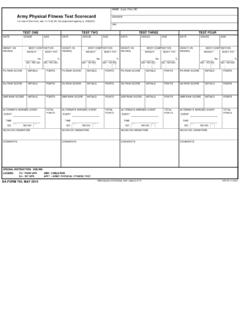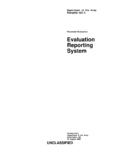Transcription of (DA Form 67-8). - Defense Technical Information Center
1 Ab-R126 773 US ARMY OFFICER PERCEPTIONS OF THE MN OER (DR FORK 1/267-8)(U) naval ' postgraduate school monterey CAA CHARDY ETAL. DEC 82 UNCLASSIFIED .F/G 5/9 NsmhhhhhhhhhiEhhhhhhhhhhhhIEhhhhhhhhhhhh EEhhhhhhhhhhhhIEhhhhhhhhhhhhEEhhhhhhhhhh hhE-~. ' -, 'Sim,. HJhi4 w RESOLUTION TEST CHARTNATIONAL. BUREAU OF STANDARDS-1% ..n.. naval postgraduate SCHOOLM onterey, ARMY OFFICER PERCEPTIONSOF THE INEW OER ( da form 67 -8)byAllan C. HardyandKeith B. HarkerDecem!rer !, P2L,.C, Advisor: Richard A. McConialApproved for public r-elease, distributionu Lr%"4 I::i < ------SeCUSTV CLASSIPICATI00 Or TNIS PASI fmb u10 DuOW_Pw RI DOUMNTATMI PAGE 8 RrAD! NSTWU(?LnN$ FVnWOWTm~mwnACCIESSION S. naciplaNT's CATALOG Mumaaf4. T5r a (m utsoe S. TYPE Or miPm0T a PmeOO Army Officer Perceptions of the Master's ThesisNew OER ( da form 67 -8) December 19826. PENPImlnG 001G. 4 EPORT Nunesm7.))
2 AUTHOi S) a. OnwlY&AT aO GANAT wimGplurAllan C. HardyKeith B. HarkerS. PIRPOMIIG OUNIDaMATIOW mMI AN0 1000111 10. P8OG8AN CL WrENT. |A a wool( umiT Mumma*$lNaval postgraduate SchoolMonterey, CA 93940I,. CONTMOLLING OPFICS MAM A4O ADODIRU OATSN aval postgraduate school December 1982 monterey , CA 93940 s 2U8 rO, IIITOUUMG AG9 NCY MAs 6 AOOUEU(If 4 WfemI 10 OliO) .SECURITY CLASS. (of ECLASSIPICAIIONDOsWWGRACueo01. OST"IEUTiON STAYiEN? (' Ste )Approved for public release, distribution unlimited.'7. OISTOIUTION STATEMENT (Of the a S .Iut aG tINd 1" 8l"A120 11 41d11f#ef t m RIeNNSA )IS. SUPpoLMENTAUY MOTES9. g L[ wOS60 (Ca * MW. mmo o smd If m meIv ad #40dI IA )Officer Evaluation, Officer Evaluation Report, Appraisal SystemsPerformance Appraisal, Efficiency Reports, OER, form 67-8,Fitness Reports20. AOSTRACT (CWUNMIS tee efds If 00OO4 IoP Md Ap mWOW)The Army has long been trying to develop a performanceappraisal system which allows selection boards at Departmentof the Ar-my to discriminate among officers (for promotion,schooling, and assignments), while also providing for theprofessional development and counseling of these current Army Officer Evaluation Report ( da form 67 -8),-which was adopted in November 1979, is largely based uponthe conceots ofg anaaPmpnt i-Nv nbi'oCtiVz (=4R -_D " 1473 o0,TOM OF O I Sov ii OUSOLETISiN O102*014" 6i0| SECUNITY CLASSIICATION OF THIS PAGE (Wma 0 a ISeWII"I--z;-In order to determine the perceptions of Army Officersin the field concerning this OER* a sample of officers in thegrades of 0-3, 0-4, and 0-5 from the three Army installationsin central California was surveyed by the authors.)))]
3 Theresults of this survey show a high general level of supportfor keeping the present OER, even though specific problemareas do exist where the perceptions of the officers surveyeddiffer significantly from published official statements --Accession ForNiTIS* GRA&IDEIC TAB Ethiatuounced [7 Justif icatirL-By~ --t v, Codes-DD FormU 1473 Jari # '0% IRCUS19" c6 AUSUtAV,.M or yule Pasgem eq 0e00 dApproved for public release: Distribution Army Officer Perceptions of the New OER ( da form 67 -8)byAllan C. HardyCaptain, United States ArmyBS., College of William and Mary, 1975andKeith B. HarkerCaptain, United States ArmyBS., University of Delaware, 1977 Submitted in partial fulfillment of therequirements for the degree ofMASTER OF SCIENCE IN MANAGEMENT from theNAVAL postgraduate SCHOOLD ecember, 1982 Authors: Approved by:esis isorChairman, Depart. of Administrative sciencesDean of Information and Policy Sciences3 ABSTRACTThe Army has long been trying to develop a perfor-mance appraisal system which allows selection boards atDepartment of the Army to discriminate among officers (forpromotion, schooling, and assignments), while also providingfor the professional development and counseling of theseofficers.]
4 The current Army Officer Evaluation Report (DAForm 67-8), which was adopted in November 1979, is largelybased upon the concepts of management by objectives (MBO).In order to determine the perceptions of Army officersin the field concerning this OER, a sample of officers inthe grades of 0-3, 0-4, and 0-5 from three Army installationsin central California was surveyed by the authors. Theresults of this survey show a high general level of supportfor keeping the present OER, even though specific problemareas do exist where the perceptions of the officerssurveyed differ significantly from published official state-ments and OF CONTENTSI .INTRODUCTION .. 9" A. PURPO SE .. 9B. BACKGROUND 0C. THE STUDY CONCEPT .. 12D. ORGANIZATION o .. 14II. BACKGROUND AND LITERATURE REVIEW .. 15A. EARLY HISTORY .. 15B. TOWARDS A PERMANENT SYSTEM (1890-1922) .. 18C. INITIAL form 67.
5 20D. SUBSEQUENT FORMS 67 .. 22E. PRESENT SYSTEM: da form 67 -8 .. 31 III. METHODOLOGY ..*.. 35A. SELECTING A SAMPLE ..o ..B. THE SAMPLE .. 36C. INSTRUMENTATION o.. 38D. ANALYSIS ..44IV. RESULTS, ANALYSIS AND DISCUSSION .. 46A. GENERAL .. 46B. ANALYSIS AND RESULTS .. 481. Number of OERs Received and Completed .. 51(Familiarization)2. Helpfulness of OER Support form .. 533. Rater/Senior Rater Qualifications for .. 54 Assessing Performance and Potential54. Perceptions of Scores and Ratings on .. 55 Promotion Opportunity5. Comparison Base for Potential .. 576. Perceived Importance of Specific OER .. 58 Sections7. Perceptions of Rating Score Inflation .. 608. Identification of Officers of Least and .. 62 Greatest Potential9. Perceptions of Scores and Ratings on .. 64 Promotion Opportunity of Others10. OER Replacement .. 6811. Discussions with Rater .. 7112.
6 OER Accuracy in Assessing Abilities .. 7413. Evaluation Technique Preferences .. 75S14. Comment s .. o ao 6 7 9V. CONCLUSIONS AND RECOMMENDATIONS .. 84A. GENERAL ..84B. CONCLUSIONS .. 85C. RECOMMENDATIONS .. *..*.. 91 APPENDIX A WD AGO form 67 -1 JULY 1936 .. 94 APPENDIX B WD AGO form 67 -1 FEB 1945 .. 96 APPENDIX C WD AGO form 67-1 o ..*.. 98 APPENDIX D da form 67 -2 .. 101 APPENDIX E da form 67 -3 .. 103 APPENDIX F da form 67 -4 .. 105!APPENDIX G da form 67 5 oeooo*,**..oo 107 APPENDIX H da form 67 -6 .. o* 109 APPENDIX I da form 67 -7 .. *.*..* . J da form 67 -8 .. 113 APPENDIX K da form 67 -8-1 .. 115 APPENDIX L da form 67 -8-2 .. 117 APPENDIX M SURVEY QUESTIONNAIRE .. 118 LIST OF REFERENCES ..124~BIBLIOGRAPHY .. 126 INITIAL DISTRIBUTION LIST .. 1287 LIST OF TABLESI. RANK OF RESPONDENTS .. 39II. SEX OF RESPONDENTS .. 39 III. RACE OF RESPONDENTS .. 40IV.
7 SOURCE OF COMMISSION .. 40V. BRANCH OF RESPONDENT .. 41VI. COMPOSTION OF ACTUAL ARMY AND SAMPLE POPULATIONS .. 42 VII. SUMMARY TABLE OF MEANS FOR SURVEY QUESTIONS .. 49 VIII. NUMBER OF OERS RECEIVED BY RESPONDENTS .. 52IX. NUMBER OF OERS COMPLETED BY RESPONDENTS .. 52X. COMPARISON OF MEANS FOR QUESTION 12 AND QUESTION 22. 66XI. COMPARISON OF MEANS FOR QUESTION 13 AND QUESTION 23. 66 XII. COMPARISON OF MEANS FOR QUESTION 25 AND QUESTION 14. 69 XIII. RESULTS OF QUESTION 26 (OER SHOULD BE REPLACED) .. 69 XIV. DISCUSSIONS WITH RATER IN LAST 6 MONTHS .. 72XV. EVALUATION TECHNIQUES MOST PREFERRED BY OFFICERS .. 76 SURVEYEDXVI. EVALUATION TECHNIQUES LEAST PREFERRED BY OFFICERS .. 77 SURVEYED8I. INTRODUCTIONA. PURPOSEThe thrust of this thesis involves the examination of theperceptions of Army officers in the field concerning thepresent Officer Evaluation Report System (OERS).
8 This willbe done by utilizing the results of a survey instrument de-signed by the authors and administered to army officers atthree local installations. By doing this, it is hoped thatareas in which common perceptions are held may be identifiedand analyzed. It is one hope of this thesis that thesecommon perceptions will agree with recent optimistic findingstentatively espoused by Department of the Army (DA). If thisis the case, then this study will lend further credence tothe statements and claims being made by the common perceptions do not agree with these state-ments and claims, then the da form 67 -8 system may encounterresistance in the future. It is not the aim of this study topass judgement on the present OERS nor to predict its ulti-mate success or failure. However, if there are commonly heldperceptions about this latest evaluation report which run4 counter to the statements and claims being made by DA offi-cials, then it would behoove these officials to become awareof these differences as quickly as basic hypothesis of this thesis, then, is that theperceptions of Army officers in the field concerningthe effectiveness of the da form 67 -8 Officer EvaluationReporting System are in agreement with the statements alreadypromulgated by officials at Department of the Army, results of this thesis should either support or refute thepreceding , where possible.
9 This thesis will qualita-tively assess whether or not some previously held perceptionsconcerning earlier officer evaluation reporting systems havechanged with the institution of the DA form BACKGROUNDThe Army Officer Evaluation Reporting System (OERS)is the product of many years'of research and development. Itis part of a performance appraisal system that has few equalsin the industrial or academic worlds based upon its size,complexity, and is of paramount importance that every officer under-stand the purpose of the officer Evaluation Reporting report is designed and intended to provide useful andmeaningful Information about each officer to Headquarters,Department of the Army (DA). This Information becomes thebasis for making personnel management decisions which involveevery aspect of an officer's career to include promotion,assignments, selection for military and civilian schools, on active duty, entry into a Voluntary Indefinitestatus, and in some cases, a current Army Officer Evaluation Report -DA Form67-8 -is the 16th revision since World War I, and the seventhversion of the form 67 series since 1947.
10 The purpose of thisform and its predecessors was to provide a more useful, accu-rate, and equitable performance management system, as wellas to control the problem of rating inflation (Consistentlyplacing an inordinantly large percentage of officers at thehigh end of a rating scale). Although the control of inflationhas been a major goal of these forms, it has not been adequatelyachieved within the last fifty as he introduced the latest Army Officer EvaluationReport System (OERS) in 1979, then Army Chief of StaffBernard Rogers cautioned that "officers should not expectthe new OER form to cure the inflation scoring problems withinthe Army evaluation system." In testifying before the HouseAppropriations Subcommittee, he said the experience of earlierevalution reports indicates that the new OER will probably4 encounter high-score problems as officers become familiar withthe intricacies of the scoring system.














